As Jean Paul Gaultier’s Theatrical Production ‘Fashion Freak Show’ Rolls Into Milan and Barcelona, He Reflects on His Career

Back in the late ’80s, it was suggested to Jean Paul Gaultier that he capitalize on his soaring international fame and launch a perfume.
“I prefer to make a record,” was his retort — and the backstory to his quirky, 1989 electro-pop album “How to Do That,” which introduced a new audience to his corsetry, cage-like tailoring, dresses with conical breasts — and his very strong French accent. (The album cover featured the phonetic spelling “Aow Tou Dou Zat.”)
More from WWD
“It was not that I was against it, but I found it very cliche: ‘OK, you are doing a collection, and after you should do a perfume, and then maybe cosmetics,” he relates in an interview, letting out a yelp of laughter after delivering the punchline: “I can’t say that the record brought me as much money as perfume has, but it was an experience.
“It was supposed to make the top 50, but I only made it to No. 53,” he says about the record, laughing anew at his dalliance as a recording artist.
As exuberant today at age 71 as he was in the “How to Do That” music video, Gaultier admits his fashion house developed in an unconventional, and sometimes even “chaotic” way. Contrary to most heritage players in France, he started with ready-to-wear, added couture much later, relied heavily on licenses, and started opening boutiques almost as a last step.
He doesn’t regret any of it.
“I was never a designer with a business vision, and I never had the ambition to become a master of the universe,” he says matter-of-factly, describing fashion design as a beloved game he has never tired of playing. “I never start any project with a goal, other than ‘I would love to that.’ To enjoy doing it is the most important thing.”
While he officially retired from the runway in 2020 with an unforgettable song-and-dance extravaganza, he continues to help recruit guest couturiers at the Paris fashion house that bears his name, owned by Spanish beauty and fashion group Puig, and to sketch ideas daily.
And his penchant for show business hasn’t diminished. “Fashion Freak Show,” his autobiographical all-singing, all-dancing revue that debuted in Paris to acclaim in 2018, is heading to Milan’s Teatro Arcimboldi for a two-week-plus run starting March 7, followed by a three-week engagement at Barcelona’s Teatro Coliseum kicking off April 4.
He also let slip that he has a new entertainment project up his striped sleeve: He’s been tapped as artistic director of a new animated feature film, with more details to be revealed this summer. “That’s so funny because it will also speak about what I know — fashion,” he says with a chuckle.
The designer famously costumed several big movies, including “The Fifth Element,” “The City of Lost Children,” “Kika” and “The Cook, the Thief, His Wife & Her Lover,” but this marks his first stab at a cartoon. He is already relishing that “with animation, you can even do things that are not possible in reality. It’s all special effects.”
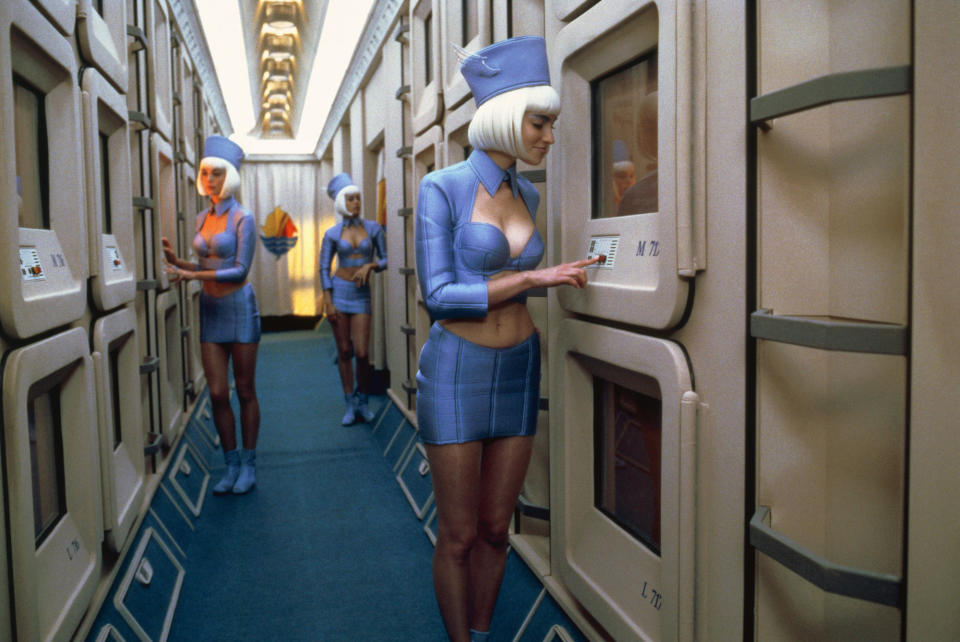
One of France’s most beloved and iconic fashion figures, synonymous with sailor stripes, kilts and his signature flat-top hairstyle, Gaultier remains very much part of the current zeitgeist, especially with gender, diversity and self-expression dominating social-media discourse among young generations.
A culture originator extraordinaire, Gaultier has been there, done all that several decades ago, simply eager to exalt different kinds of beauty.
His plays on gender were inspired by people like Edwige Belmore, a club character in the ’80s and ’90s anointed the “queen of the punks” by party people in Paris. Gaultier adored her stature, bleached hair and boyish allure. “There is not only one kind of beauty,” he stresses.
Interviewed in a dimly lit hotel suite with a faint BDSM decor, the designer also explains how much flea markets had a broad impact on his aesthetic. Early in his career, he would purchase vintage garments to examine their construction and learn from them.
But he also fell in love with the unique colors of old clothes, whether weathered by the sun, abrasions, too much laundering — or not enough.
“It was very inspiring to me, because the colors sometimes were colors that were more beautiful, like a blue that was a little yellowed,” he enthuses.
Among Gaultier’s biggest claims to fame are dressing Madonna in cone-bra lingerie and pinstripes for her 1990 tour, and putting men in skirts back in 1984.
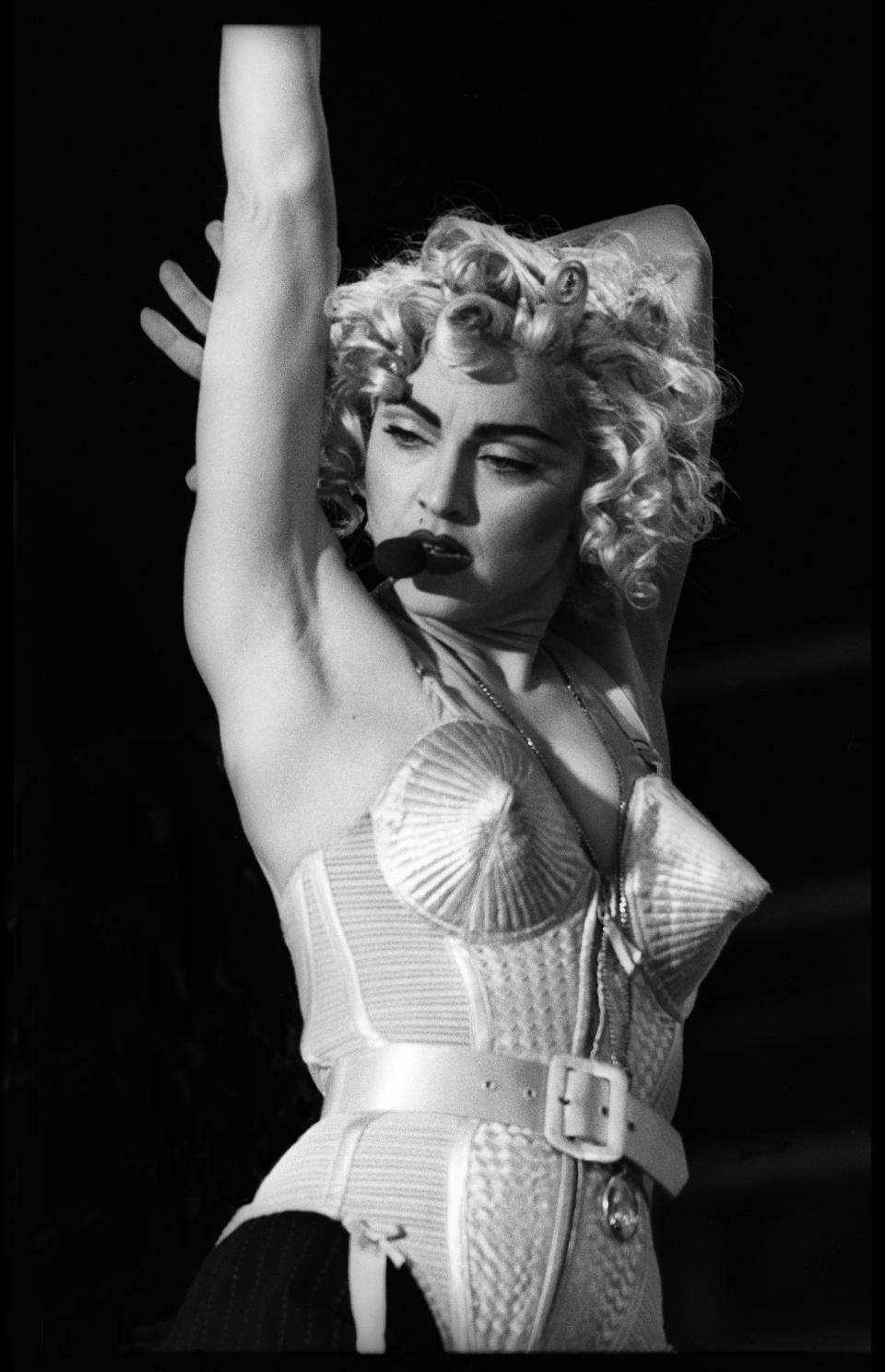
The designer can’t recall if there were many takers for his kilt- and apron-like garments for men. “In reality, it was done for men, but some women could wear it, you know,” he says matter-of-factly, recalling that his then-manufacturing partner, Italy’s Gibo, told him that some of the roomy, mannish jackets he had done in his women’s collection were being purchased by men, and that a lot of women were buying jackets from his men’s collection.
Gaultier says he very much admired the tailoring of Giorgio Armani at that time, but his take was more unconventional, and once again rooted in vintage.
“From my education in the flea markets, I realized that the size was not so important,” he explains. “Sometimes girls were buying some jackets that were not their size, often finding them too big.”
In addition to appreciating the slouchy allure of such a “boyfriend” jacket, Gaultier adores the gesture of rolling up the overly long sleeves of flea-market finds, exposing the jacket lining. He appropriated the latter as a deliberate design signature, printing the lining in his signature sailor stripes, for his first men’s collection, and later for several of his women’s shows. “I was always using that as an idea,” he says.
While skirts for men were hardly a commercial blockbuster, Gaultier hit on one with his tattoo prints, the main theme of his spring 1994 collection. He printed them on nude, stocking-like mesh, which was considered a first in ready-to-wear, and they sold up a storm.
History repeated itself in 2023 when the house reissued tattoo styles, which showed up almost immediately on the likes of Bad Bunny, Kylie Jenner and Ice Spice. With all things ’90s and Y2K trending among young generations, the Gaultier house, now led by fashion creative director Florence Tétier, has dropped capsules paying tribute to a 1995 collection based on the Op Art patterns of French artist Victor Vasarely, and, more recently, a Dress Like Jean Paul range hinged on tartan kilts and sailor stripes and caps.
Clever, irreverent takes on denim and boxing attire are among other Gaultier-isms that still have oomph and legs, giving the current ready-to-wear design studios — and guest couturiers — plenty to riff on.
Some of Gaultier’s fashion inventions owe a debt to shoestring budgets back in the day.
The designer is blunt that his early years in the business were a struggle, and to stay afloat he cut a deal with Gibo whereby he would design its in-house collection, including a raincoat range named Bogeys after a certain Humphrey, if it would manufacture and distribute his signature ready-to-wear.
“Because I had no money, I really had to be creative,” he recalls. “I remember that for one of my first shows, I had no budget for shoes, so I put the models in thick, wintry socks and I glued a sole on the bottom.”
Who knew that Gaultier was the inventor of sock boots, almost 50 years before Vetements and Kanye West sparred on Instagram over who did it first? (#NothingBeatsTheOriginal was the hashtag at the center of the online feud.)
Chalk it up to Gaultier’s capacity for invention; the ingenuity that financial constraints require; his rebellious, yet playful spirit, and an eye that is forever roaming in search of new stimuli.
Elaborating on the sock-shoe example, Gaultier says he later pulled actual socks over high-heeled boots, letting the stilettos poke through a dedicated hole at the heel.
“It was always about how to make something out of nothing,” he says.
The designer also relishes such contradictions, which compelled him to design what were probably the first high-heeled sneakers for his spring 1988 Junior Gaultier range, and to zhush up humble fashion archetypes like blue jeans or a sailor top into breathtaking haute couture creations.
“I didn’t start out with much money which gave me freedom in a way…. you have to be more creative,” he says.
Yet his house would become internationally known, and a pillar of the French fashion scene. He established his beauty business in 1991, joined the couture calendar in 1997, and launched an accessories division in 2000.
Asked how he sustained such an enviable creative output over almost half a century, he simply shrugs, explaining that “it was always a joy to play my game of fashion.”
He didn’t even need to take exotic inspiration trips, for his roving eye always absorbed plenty from his adopted city of Paris and its denizens, from London’s Portobello Road and Camden flea markets, and from his insatiable appetite for cinema, theater and television, good or bad.
And while his motivation was always to mount a theatrical, spectacular fashion show, he also knew he “had to make clothes that were wearable and not only extravaganzas.”
Gaultier started his company in 1976, and catapulted the French capital’s reputation for fashion in the ’80s alongside fellow fashion mavericks Claude Montana and Thierry Mugler. He was long described as the “enfant terrible,” or wild child, of the Paris scene.
Entirely self-taught, Gaultier’s eyes were first opened to the possibility of a career in live events when, at age nine, his grandmother let him watch the premiere of the Folies Bergère in black and white.
But discovering Jacques Becker’s 1945 movie set in the world of haute couture — “Falbalas” (or “Paris Frills” in English) — sealed his fate. He’s since watched it at least 30 times, and considers the film his true fashion school.
Indeed, one can draw a line between the cinched waists of the Marcel Rochas gowns depicted in “Falbalas” and the corset dresses and bodysuits that would become Gaultier signatures.
After sketching designs for his mother and grandmother as a teenager, including one of a coat he invented with rucksack closures, he dispatched his portfolio to several fashion houses, and to Space Age couturier Pierre Cardin, who engaged him as a design assistant for two years. Gaultier later worked for Jacques Esterel and Jean Patou before launching his signature ready-to-wear with a subversive streak and a streetwise edge.
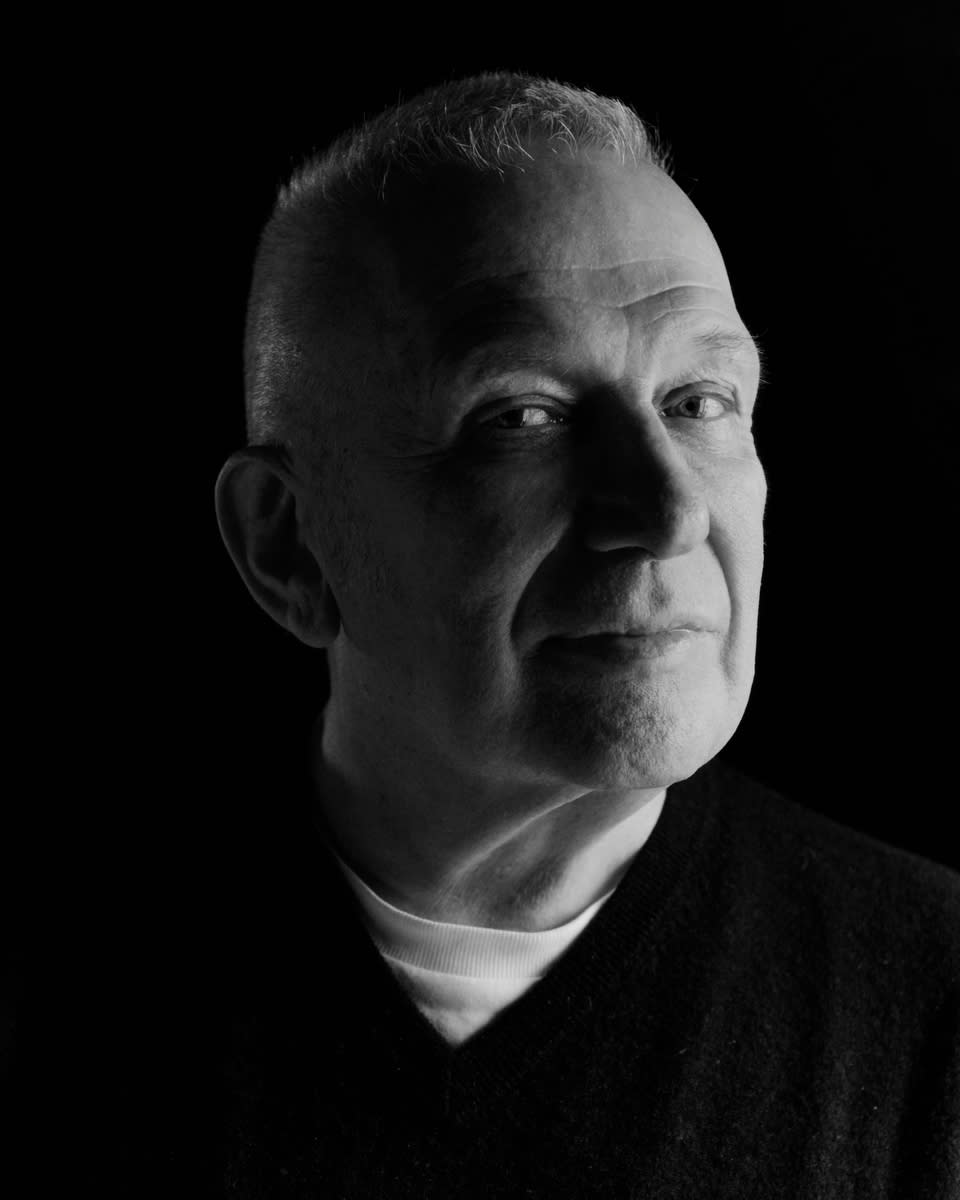
In the interview, Gaultier lauded his time at Cardin’s elbow. “There I discovered everything,” he enthuses. “He was so creative, and also a businessman. He was the accountant and the man who wrote all the paychecks, but at the same time he could cut, he could drape, and think about the fashion show and how to make it spectacular.”
Gaultier marvels how the designer incorporated dramatic lighting, projections and wonky, electronic music into his shows at a time when stiff, formal salon affairs were the norm. “It was completely incredible, very modernist,” he says.
From Cardin, he also learned many couture techniques, but also that it’s important not to be enslaved by them. He recalls being shocked to witness Cardin hand-cutting strips into the hem of a dress or skirt, and zig-zag stitching the edges with a machine to stem fraying, rather than neatly hemming them. But he did so to achieve lightness and free movement of the fabric.
Likewise, the young Gaultier was stunned when Cardin asked an assistant to fetch a fabric that had been in storage for his new collection. “But I learned one should have the freedom to use a fabric from five years ago if it goes with what you want to do, if it has the weight, color or prints you need.”
In turn, Gaultier has hired and trained several designers who would go on to international acclaim, headlined by Martin Margiela and Nicolas Ghesquière.
He recounts his discovery of Margiela with zeal. He had been invited to be on a jury for fashion students from Antwerp’s Royal Academy of Fine Arts, and “it was the year of the seven,” he marvels, lumping Margiela in with the famous Antwerp Six that emerged in the early ’80s: Walter Van Beirendonck, Ann Demeulemeester, Dries Van Noten, Dirk Van Saene, Dirk Bikkembergs and Marina Yee.
Gaultier was astonished at the professional calibre of the entire Belgian crew. He put Margiela second in his scoring, “but I liked him.” When the young Belgian approached Gaultier to come work for him as an assistant, the Frenchman initially spurned him, partly because he didn’t work with assistants, and because he didn’t have the budget.
But he reconsidered and took Margiela on to help with the Gibo trenchcoat collection, and assist with fabric selections for his signature collection. “He was so good and we truly became friends,” Gaultier says.
He recalls one meeting at a top fabric house in Italy where he and Margiela were presented with — no joke — something like 500 varieties of gabardine. One imagined a scene akin to a clown pulling an endless handkerchief out of his pocket, leaving the two men so flabbergasted, they could only laugh uncontrollably, much to the chagrin of the salesman.
“It was like a strange dream about gabardine, but at the same time a nightmare,” Gaultier says, laughing anew. “It was something so unique in my life — so many gabardines! But you know, I learned something that day: Don’t make too much!”
Gaultier also recalls how pleased he was when Margiela decided to branch out with his own collection in 1988.
“He saw how I was working and I think he wanted to make exactly the opposite of what I was doing,” he says, breaking into yet more laughter, but then insisting: “It’s true! In reality it’s like that, that’s how you react to things… Because you are younger, you want to do things differently, to break the rules.”
“His first collection was truly already super professional, but nice with a completely different style.”
In a unique full-circle moment, Gaultier would in 2003 succeed Martin Margiela as the women’s ready-to-wear designer at Hermès, which had begun investing in the Gaultier house in 1999. Gaultier would remain at the tony brand, where he playfully plied the equestrian theme and designed several hit handbags, until 2010.
The next year, Barcelona-based Puig purchased the 45 percent of Gaultier held by Hermès International plus roughly 15 percent from the founding couturier, giving the designer a new lease on life and making Puig — parent of Nina Ricci, Carolina Herrera and Paco Rabanne — a bigger and more formidable player on the international fashion scene.
“Jean Paul Gaultier has always been a visionary,” enthuses Marc Puig, chairman and chief executive officer of Puig. “He did nearly everything before others in the fashion industry, and today, his authenticity and originality are highly valued. I believe that younger generations are drawn to this aspect and recognize him as a pioneer in numerous ideas and issues that still resonate with them today.”
And although Gaultier hung up his scissors in 2020, he decided to remain active in the brand.
“He continues to transmit his energy, his creativity and his savoir-faire to the teams, and his celebration of the collections of his guest designers is the ultimate endorsement,” Puig says. “It’s an immense responsibility to be entrusted with one’s legacy and we have always been committed to carrying our founders’ vision forward long after they retire.”
In Puig’s estimation, Gaultier occupies an important place in fashion history for he has “advocated for diversity and inclusivity since his very first collections. He has set himself apart with an idea of fashion that challenges boundaries and conventions at every turn. His fiercely revolutionary character and spirit, coupled with the freedom he has championed throughout his career have profoundly impacted the industry. And he has paired all this with exceptional couture skills and savoir-faire. It is a unique combination and one of the reasons why he is so widely appreciated and respected today.”
Gaultier explains his retirement from the runway as simply being “interested in doing something different, but not to finish completely with fashion.” Indeed, his “Fashion Freak Show” cabaret, which debuted in Paris in 2018, was simply another way of indulging his passion for blending fashion with showmanship.
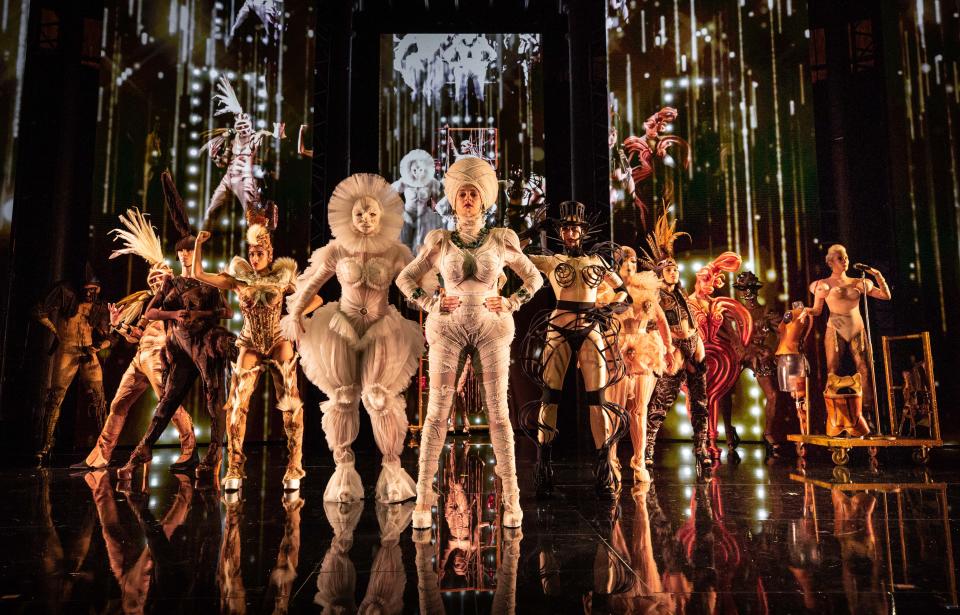
He’s also the creative guru behind “Falling | In Love,” a massive cabaret-style revue at Berlin’s Friedrichstadt-Palast, the state theater owned by the City of Berlin. The project represents an encore for Gaultier, who had designed around 500 costumes for “The One” revue that opened there in 2016, fulfilling a childhood dream.
“In the beginning, I discovered fashion shows through the cinema, and I always wanted to make fashion shows spectacular, like the theater. Even my first show, it was quite spectacular because it was a spectacular disaster,” he says, laughing uproariously.
He alludes to this in the autobiographical “Fashion Freak Show,” when the music blares, the runway lights go up, but the models are not ready because Gaultier was still deciding what to put on them.
“I went without rehearsals for something like 20 years,” he says. “With me, it had to be always spontaneous because I was always changing things, preferring to always be creative until the last moment.”
Hailing from the small French town of Loudun, and without any formal fashion training like Gaultier, Ghesquière was dead set on working for his fashion hero, and got his start by filing, photocopying and cataloguing fabrics at Jean Paul Gaultier.
“I always see Jean Paul as a game changer for our industry, and for our freedom as designers,” says Ghesquière, artistic director of women’s collections at Louis Vuitton since 2013 and formerly the acclaimed creative director of Balenciaga. “He made propositions that were totally new in the way of not only dressing and styling, but he was also the first one to express the world of today: I’m talking about inclusivity, about different body shapes, about gender identity. Jean Paul was really ahead of his time to make sure everyone was invited to the table and represented in his fashions.”
In an interview, Ghesquière marvels at Gaultier’s unique ability to mix so many disparate references to create something totally new.
When he worked at the house, the teenage Ghesquière witnessed various factions of the studio working on radically different styles and stories, “and Jean Paul was the only one with the magical key to put together everything together at the end. Everything would come together and it was brilliant.
“It’s something that I had never seen before, and I remember it being very emotional for me. I was young and dazzled by that talent,” he says. “His unique combination of styles is very precious for our industry.”
What’s more, the budding young designer witnessed a couturier who was uncompromising in fittings, always seeking perfection, and who nurtured a “point of view that was always very free and very creative.”
Ghesquière says he’s forever grateful for Gaultier putting him “on the right lane… I know if I’m here today, it’s because of the way I was treated and taken care of when I was so young at Jean Paul Gaultier.”
He also lauds Gaultier’s idea of rotating guest couturiers, which to date have included Sacai’s Chitose Abe, Balmain’s Olivier Rousteing, Y/Project’s Glenn Martens, Rabanne’s Julien Dossena, Haider Ackermann and Simone Rocha.
“It was so smart of him to help people understand how much he’s a part of our collective aesthetic and culture: Everyone has a point of view on what he does,” Ghesquière says.
The designer highlights how reassuring it was as “a young gay man that was not completely comfortable with his sexuality at the time” to see Gaultier so present in the media as a strong, proud figure for the LGBTQIA+ community.
Up-and-coming Paris designer Victor Weinsanto, who worked with Gaultier on costumes for the “Fashion Freak Show” revue before launching his own brand Weinsanto, calls Gaultier “the most avant-garde designer of his generation.”
“Today it has finally become normal to have an inclusive and eco-responsible approach, but at the time it was revolutionary,” Weinsanto says. “I have enormous admiration for what he brought to fashion and to society. People from my generation, we are all very grateful to him.”
In terms of fashion design, Weinsanto argues that Gaultier’s work was so prescient “that it is still so cool and modern,” he says, citing an affection for wearing vintage Gaultier pieces from the ’90s, with their unmistakeable prints.
“The inspiration that we can have from his work and his heritage is inexhaustible,” he says. “Jean Paul Gaultier’s vintage and current pieces are the coolest and it makes me happy to see that the younger generations are perpetuating his positive, caring message.”
Weinsanto, who trained at Atelier Chardon Savard Paris and has also worked at Y/Project, Maxime Simoens and Chloé, says he “learned everything” by watching Gaultier work, discovering “exciting techniques and know-how.”
When Weinsanto decided to leave the Gaultier house and launch out on his own, he gave the designer a bouquet to thank him.
“I will always remember what he said to me that day,” Weinsanto recalls. “He said, ‘We are in a serious business but we have the chance to do a fun job. You have to have fun and listen to your instincts.'”
EDITOR’S NOTE: The Originals is an occasional feature in WWD dedicated to mavericks in fashion, beauty, retail and culture.
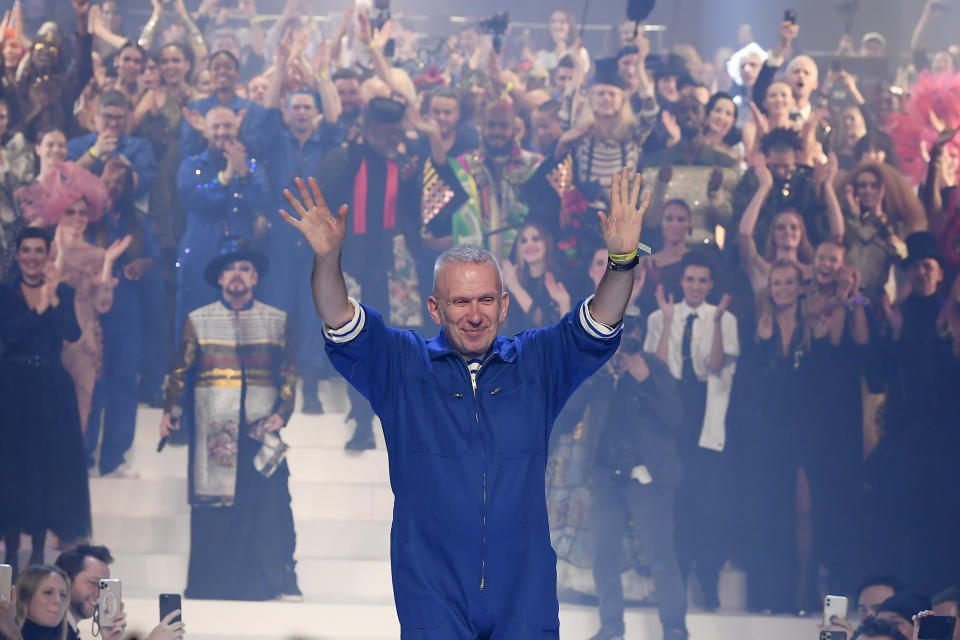
Launch Gallery: Jean Paul Gaultier Extraordinary Career Through The Years
Best of WWD